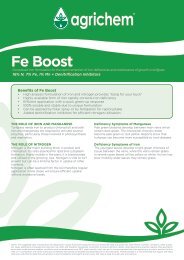Pitstop - PIS_AUS.pdf - Agrichem
Pitstop - PIS_AUS.pdf - Agrichem
Pitstop - PIS_AUS.pdf - Agrichem
- No tags were found...
You also want an ePaper? Increase the reach of your titles
YUMPU automatically turns print PDFs into web optimized ePapers that Google loves.
<strong>Pitstop</strong>High analysis liquid calcium for strengthening cell walls and correcting calcium deficiency17% CaBenefits of <strong>Pitstop</strong>• Aids in the prevention of Bitter Pit, Blossom End Rot and Tip Burn• Aids in extending shelf life of fruit• Buffered to improve uptake and minimise phytotoxicity• Cost effective for both foliar spraying and post harvest dipping• 100% soluble nutrient provides high plant availability facilitating rapid correction ofdeficiency• Clear liquid formulation makes it easy to decant into spray equipment, mixing and irrigationtanks• Can be applied with a wide range of agricultural chemicals, reducing the number of sprayapplications neededTHE ROLE OF CALCIUMCalcium is required for the cellulose precursors for cellwall formation. It also stabilises cell membranes andprotects them – an important attribute under stressconditions. In fruit crops it is required in high quantitiesand is important for fruit quality and shelf life. It is alsoknown that when plants are threatened by infection,calcium binds to a protein called calmodulin thatprompts plants to manufacture salicylic acid (SA), aclose chemical relative of aspirin. SA acts as a signalmolecule that kicks off a series of reactions that helpdefend against external threats (SAR response).Deficiency Symptoms of Calcium• Bitter pit in apples - slight indentations in theskin which become brown as does the fleshbeneath• Tip burn in strawberries and lettuce - deathand puckering along the edge of the youngestleaves• Blossom End Rot in tomatoes and cucurbits• Growing point can die where roots becomestunted and brown, while leaf stalks developbrown lesions and collapse• Generally, softer fruit with lower shelf lifeNOTE: The suggested rates of application are designed for typical Australian conditions and such should be used as a guide only. Each farmer’s climatic conditions, water quality,soil types, application processes and practices may differ and therefore necessitate corrections to ensure optimum results. Good agricultural practice requires that applicationbe avoided under extreme weather conditions such as temperatures over 28 o C, high humidity, frost, rain etc. It is recommended that when applying to a crop or area for the firsttime, or in combination with other chemicals, a small test area should be sprayed and observed prior to the total spray. Where possible, it is recommended that regular leaf (sap)tests are conducted to determine actual plant nutrient availability during each growth cycle. Soil tests at least once per year are essential.
Product CharacteristicsSpecific Gravity: 1.35 - 1.37 Colour: Green LiquidAnalysis Australia (w/v%) International (w/w%)Calcium (Ca) 17.0 12.5CROPAVOCADOS- Foliar- FertigationBANANAS- Foliar- FertigationDirections for UseAgitate contents well before dilution. Suitable for application by:Rate/ha3 - 7 L7 - 10 L3- 5 L5 - 10 LMINDILUTIONCOMMENTS1 : 100 Apply post flowering onwards at 14 day intervals1 : 100 Apply from bellingBRASSICAS, LETTUCE 3 - 10 L 1 : 50 From 2 weeks after transplant. Apply as required.CUCURBITS 3 - 5 L 1 : 100 Apply 1 spray prior to flowering, then every 14 days from fruit setto harvestCITRUS 5 - 10 L 1 : 100 Apply from post flowering onwards at approximately 7 - 10 dayintervalsONIONS 7 - 15 L 1 : 50 Apply from 6 weeks at regular intervals or as requiredPINEAPPLES 3 - 7 L 1 : 100 Apply pre-flower and there after at 14 day intervals as requiredPOME FRUIT- Foliar- Post Harvest Dip:Apples- Golden Delicious- Other Varieties5 - 10 L0.6 L / 100 L2 - 2.5 L / 100 L1 : 100From petal fall 7 - 14 days apart until harvest. Treat the fruit assoon as possible after harvestWhilst dipping fruit increases shelf life, be aware that there is a riskof fruit damage from using this procedure.When dipping aim for as small a differential as possible betweenthe temperature of the fruit and the temperature of the dipsolution. It may be advisable to cool the fruit before treatment.Dip for 30 - 60 seconds. Change dip regularly. Dirty dip causesslow drying of fruit and more risk of skin injury. Fruit MUST bedry before going into storage as skin damage may occur. Waterrinsing fruit 24 hours after dipping reduces riski of fruit damagePOTATOES 7 - 10 L 1 : 100 Apply from 6 weeks at regular intervals or as requiredSTONE FRUIT- Fertigation 8 - 12 L 1 : 100 Apply from petal fall onwards at approx 7 - 14 day intervalsSTRAWBERRIES 2 - 4 L 1 : 100 Apply at 10 - 14 day intervals as requiredTROPICAL FRUIT:Paws Paws, Mangoes- Foliar- Fertigation3 - 7 L5 - 10 L1 : 100 Apply pre-flower and post-flowering at 14 day intervals asrequiredTOMATOES 7 - 15 L 1 : 50 Apply at flowering and thereafter at 14 day intervals as required.TURFVINESTable & Wine Grapes- Foliar 5 - 7 L or0.5 - 1.4 L /100 LFoliar Spray Fertigation Post Harvest Dip20 L1 : 20 Apply at 14 - 28 days intervals200ml / 100m 2 Typically dry leaf analysis should show Ca levels between 0.35 - 1%in couch (fairways, lawns etc) and between 0.2 - 1 % in bent grass1 : 100 Apply at fruit set, then 3 applications 2 - 3 weeks apart. DO NOTexceed 2x concentration. DO NOT exceed maximum per hectarerate. Minimum water rate 500 L / haMinimum Dilution: A dilution of 1 : 100 means 1 part product : 100 parts waterIn hot weather, use the higher dilution rate where applicable.** AERIAL APPLICATION: Use maximum practical water rates<strong>Agrichem</strong> Head Office: 2 Hovey Road, Yatala QLD 4207, AustraliaPh: +61 7 3451 0000 Fax: +61 7 3451 0093 Free Call: 1800 65 47 58Email: enquiries@agrichem.com.au Web: www.agrichem.com.au
















